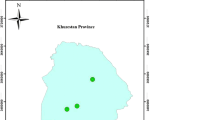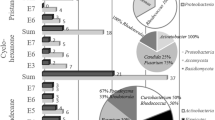Abstract
Crude oil pollution is one of the most arduous issues to address, as it is hazardous to both public health and the environment. The discovery of novel biosurfactants-producing fungi and bacteria is in high demand due to their excellent properties and wide range of applications. The aim of this research is to isolate a powerful biosurfactant-producing fungus from the crude oil site near Barauni oil refinery in Bihar, India. Standard protocols were used to collect samples from the site. An integrative taxonomic approach was used, which included morphological, molecular, and phylogenetic analysis. The use of plating samples on Bushnell-Hass (BH) media aided in the isolation of a fungal strain from an enrichment culture. Two fungal strains isolated from contaminated soils, Penicillium citrinum and Paecilomyces variotti, showed potent oil degrading activity in a single culture. For preliminary biosurfactants screening, drop collapse assays, oil spreading, and emulsification activity tests were used. The results showed that the cultures performed well in the screening test and were further evaluated for degradation capacity. Different treatment periods (0, 3, 6, 9, 12, and 15 days) were used to observe degradation in single cultures. A steady drop in pH, an alteration in optical density and an increase in carbon dioxide release showed the ability of fungal strain to degrade the crude oil in a single culture. Fungi mycelia provide a larger surface area for absorption and degradation of the pollutants in contaminated environment. They produce extracellular enzymes to degrade the oil, and at the same time absorb and utilise carbon, allowing them to remove toxic substances from the oil. Thus, they could be candidates for bioremediation of a hydrocarbon-contaminated site.





Similar content being viewed by others
Availability of data and materials
All data generated or analysed during this study are included in this published article. Data about the DNA sequences mentioned in the manuscript are submitted in NCBI-GenBank.
References
Al-Hawash AB, Alkooranee JT, Abbood HA, Zhang J, Sun J, Zhang X, Ma F (2018a) Isolation and characterization of two crude oil-degrading fungi strains from Rumaila oil field Iraq. Biotechnol Rep 17:104–109
Al-Hawash AB, Alkooranee JT, Zhang X, Ma F (2018b) Fungal degradation of polycyclic aromatic hydrocarbons. Int J Pure Appl Biosci 6:8–24
Aneja KR (2003) Environments in microbiology plant pathology and biotechnology, 4th edn. New Age International New Delhi, New Delhi, p 97
Asemoloye MD, Tosi S, Dacco C, Wang X, Xu S, Marchisio MA, Gao W, Jonathan SG, Pecoraro L (2020) Hydrocarbon degradation and enzyme activities of Aspergillus oryzae and Mucor irregularis isolated from Nigerian crude oil-polluted sites. Microorganisms 8:1912
Bainier G (1907) Mycotheque of the School of Pharmacy - XI. Paecilomyces a new genus of Mucédinea. Q Bull Mycol Soc France 23(1):26–27
Balaji V, Arulazhagan P, Ebenezer P (2014) Enzymatic bioremediation of polyaromatic hydrocarbons by fungal consortia enriched from petroleum contaminated soil and oil seeds. J Environ Biol 35:521–529
Balba MT, Al-Awadhi N, Al-Daher R (1998) Bioremediation of oil-contaminated soil: microbiological methods for feasibility assessment and field evaluation. J Microbiol Methods 32(2):155–164
Banat IM, Satpute SK, Cameotra SS, Patil R, Nyayanit NV (2014) Cost effective technologies and renewable substrates for biosurfactants production. Front Microbiol 5:697
Bogusławska-Wąs E, Dąbrowski W (2001) The seasonal variability of yeasts and yeast-like organisms in water and bottom sediment of the Szczecin Lagoon. Int J Hyg Environ Health 203(5–6):451–458
Calmon A, Dusserre BL, Bellon MV, Feuilloley P, Silvestre F (2000) An automated test for measuring polymer biodegradation. Chemosphere 41(5):645–651
Cameron DR, Cooper DG, Neufeld RJ (1988) The mannoprotein of Saccharomyces cerevisiae is an effective bioemulsifier. Appl Environ Microbiol 54(6):1420–1425
Chaillan F, Le Fleche A, Bury E, Phantavong YH, Grimont P, Saliot A, Oudot J (2004) Identification and biodegradation potential of tropical aerobic hydrocarbon-degrading microorganisms. Res Microbiol 155(7):587–595
Chandra R, Rustgi R (1998) Biodegradable polymers. Prog Polym Sci 23(7):1273–1335
Chang YT, Lee JF, Liu KH, Liao YF, Yang V (2016) Immobilization of fungal laccase onto a nonionic surfactant-modified clay material: application to PAH degradation. Environ Sci Pollut Res 23(5):4024–4035
Cox PW, Paul GC, Thomas CR (1998) Image analysis of the morphology of filamentous micro-organisms. Microbiology 144(4):817–827
Durairaj P, Malla S, Nadarajan SP, Lee PG, Jung E, Park HH, Kim BG, Yun H (2005) Fungal cytochrome P450 monooxygenases of Fusarium oxysporum for the synthesis of ω-hydroxy fatty acids in engineered Saccharomyces cerevisiae. Microb Cell Fact 14:1–16
Ferdinand PU, Onyeocha IO, Ezeji EU, Chukwudi P, Engwa GA (2020) Biodegradation of hydrocarbons in a crude-oil polluted soil using peroxidase from fungal di-culture of Rhizopus and Saccharomyces spp. J Biotech Res 11:187–196 (ISSN: 1944-3285)
Garbisu C, Garaiyurrebaso O, Epelde L, Grohmann E (2017) Plasmid-mediated bioaugmentation for the bioremediation of contaminated soils. Front Microbiol 8:1966
Gilman JC, Joseph C (1998) A manual of soil fungi. 1st Indian Edition. ISBN 81-7622-011-6. BiotechBooks Delhi India
Hall T BioEdit version 7.0.0 (2004) Distributed by the author. http://www.mbio.ncsu.edu/BioEdit/bioedit.html. Accessed 12 Dec 2021
Horel A, Schiewer S (2020) Microbial degradation of different hydrocarbon fuels with mycoremediation of volatiles. Microorganisms 8:163
Houbraken J, Kocsube S, Visagie CM, Yilmaz N, Wang XC, Meijer M, Frisvad JC (2020) Classification of Aspergillus Penicillium Talaromyces and related genera (Eurotiales): an overview of families genera subgenera sections series and species. Stud Mycol 95:5–169
Jain DK, Collins-Thompson DL, Lee H, Trevors JT (1991) A drop-collapsing test for screening surfactant-producing microorganisms. J Microbiol Methods 13(4):271–279
Kiehlmann E, Pinto L, Moore M (1996) The biotransformation of chrysene to trans-1 2-dihydroxy-1 2-dihydrochrysene by filamentous fungi. Can J Microbiol 42(6):604–608
Kumar S, Stecher G, Li M, Knyaz C, Tamura K (2018) MEGA X: molecular evolutionary genetics analysis across computing platforms. Mol Biol Evol 35(6):1547
Leitao AL (2009) Potential of Penicillium species in the bioremediation field. Int J Environ Res Public Health 6(4):1393–1417
Llado S, Covino S, Solanas AM, Vinas M, Petruccioli M (2013) Comparative assessment of bioremediation approaches to highly recalcitrant PAH degradation in a real industrial polluted soil. J Hazard Mater 248–249:407–414
Marquez-Rocha FJ, Olmos-Soto J, Rosano-Hernandez MC, Muriel-Garcia M (2015) Determination of the hydrocarbon-degrading metabolic capabilities of tropical bacterial isolates. Int Biodeterior Biodegrad 55(1):17–23
McGinnis S, Madden TL (2004) BLAST: at the core of a powerful and diverse set of sequence analysis tools. Nucl Acids Res 32(suppl_2):W20–W25
Mineki S, Suzuki K, Iwata K, Nakajima D, Goto S (2015) Degradation of polyaromatic hydrocarbons by fungi isolated from soil in Japan. Polycyclic Aromat Compd 35(1):120–128
Mollea C, Bosco F, Ruggeri B (2005) Fungal biodegradation of naphthalene: microcosms studies. Chemosphere 60(5):636–643
Morel M, Meux E, Mathieu Y, Thuillier A, Chibani K, Harvengt L, Jacquot JP, Gelhaye E (2013) Xenomic networks variability and adaptation traits in wood decaying fungi. Microb Biotechnol 6:248–263
Moreno-Gavira A, Huertas V, Dianez F, Sanchez-Montesinos B, Santos M (2020) Paecilomyces and its importance in the biological control of agricultural pests and diseases. Plants 9(12):1746
Morikawa M, Hirata Y, Imanaka T (2000) A study on the structure–function relationship of lipopeptide biosurfactants. Biochim Biophys Acta Mol Cell Biol Lipids 1488(3):211–218
Mueller RJ, Augusta J, Pantke M (1992) An interlaboratory investigation into biodegradation of plastics. Part 1: a modified Sturm-test. Mater Organ 27:179–189
Nguyen TTT, Paul NC, Lee HB (2016) Characterization of Paecilomyces variotii and Talaromyces amestolkiae in Korea based on the morphological characteristics and multigene phylogenetic analyses. Mycobiology 44(4):248–259
Pangging M, Nguyen TT, Lee HB (2019) New records of four species belonging to Eurotiales from soil and freshwater in Korea. Mycobiology 47(2):154–164
Posada F, Aime MC, Peterson SW, Rehner SA, Vega FE (2007) Inoculation of coffee plants with the fungal entomopathogen Beauveria bassiana (Ascomycota: Hypocreales). Mycol Res 111(6):748–757
Ronquist F, Teslenko M, Van Der Mark P, Ayres DL, Darling A, Hohna S, Huelsenbeck JP (2012) MrBayes 3.2: efficient Bayesian phylogenetic inference and model choice across a large model space. Syst Biol 61(3):539–542
Saraswathy A, Hallberg R (2002) Degradation of pyrene by indigenous fungi from a former gasworks site. FEMS Microbiol Lett 210(2):227–232
Singh H (2006) Mycoremediation: fungal bioremediation. Wiley-Interscience, New York
Srivastava S, Thakur IS (2006) Evaluation of bioremediation and detoxification potentiality of Aspergillus niger for removal of hexavalent chromium in soil microcosm. Soil Biol Biochem 38(7):1904–1911
Swofford DL. 2002 PAUP*: Phylogenetic analysis using parsimony (* and other methods) Version 4.0b10, Sunderland, MassachusettsSinauer Associates.
Thom C (1910) Cultural studies of species of Penicillium. U.S.D.A. Bureau Anim Ind Bull 118:1–107
Van der Zee M, Sijtsma L, Tan GB, Tournois H, De Wit D (1994) Assessment of biodegradation of water insoluble polymeric materials in aerobic and anaerobic aquatic environments. Chemosphere 28(10):1757–1771
Vanishree M, Thatheyus AJ, Ramya D (2014) Biodegradation of petrol using the fungus Penicillium sp. Sci Int 2(1):26–31
Vilgalys R, Gonzalez D (1990) Organization of ribosomal DNA in the basidiomycete Thanatephorus praticola. Curr Genet 18(3):277–280
Vishal V, Munda SS, Singh G, Lal S (2021a) Cataloguing the bacterial diversity in the active ectomycorrhizal zone of Astraeus from a dry deciduous forest of Shorea. Biodivers Data J 9:e63086
Vishal V, Munda SS, Singh G, Lal S (2021b) Wild edible gasteroid fungus Astraeus (Diplocystidiaceae) from Jharkhand India. Indian J Appl Pure Biol 36(2):569–579
Walter V, Syldatk C, Hausmann R (2010) Screening concepts for the isolation of biosurfactant producing microorganisms. Biosurfactants. https://doi.org/10.1007/978-1-4419-5979-9_1
Wang X, Wang X, Liu M, Bu Y, Zhang J, Chen J, Zhao J (2015) Adsorption–synergic biodegradation of diesel oil in synthetic seawater by acclimated strains immobilized on multifunctional materials. Mar Pollut Bull 92(1–2):195–200
Wang XC, Chen K, Zeng ZQ, Zhuang WY (2017) Phylogeny and morphological analyses of Penicillium section Sclerotiora (Fungi) lead to the discovery of five new species. Sci Rep 7(1):1–14
Ye JS, Yin H, Qiang J, Peng H, Qin HM, Zhang N, He BY (2011) Biodegradation of anthracene by Aspergillus fumigatus. J Hazard Mater 185(1):174–181
Yoshida S, Hiraga K, Takehana T, Taniguchi I, Yamaji H, Maeda Y, Oda K (2016) A bacterium that degrades and assimilates poly (ethylene terephthalate). Science 351(6278):1196–1199
Zhang JH, Xue QH, Gao H, Ma X, Wang P (2016) Degradation of crude oil by fungal enzyme preparations from Aspergillus spp. for potential use in enhanced oil recovery. J Chem Technol Biotechnol 91(4):865–875
Acknowledgements
We would like to express our gratitude to the Department of Microbiology, DSPMU, Ranchi, Jharkhand, for providing the necessary equipment, as well as the Department of Nanotechnology, University of Calcutta, W.B, for allowing us to use their SEM facility.
Funding
Not applicable.
Author information
Authors and Affiliations
Contributions
The ideas and project were developed by SL, VK, HK, and VV. VK, and HK, were involved in the research and investigation process, particularly in sample collection and experimentation. VV, VK and HK have equally contributed in data interpretation, analysis and writing of the manuscript. All of the authors provided constructive feedback on how to implement the study, analysis, and in developing the article. The version to be submitted, as well as any revised versions, received final approval from SL.
Corresponding author
Ethics declarations
Competing interest
The authors declare that they have no competing interests.
Ethics approval and consent to participate
Not applicable.
Consent for publication
Not applicable.
Additional information
Communicated by Muthusamy Govarthanan.
Publisher's Note
Springer Nature remains neutral with regard to jurisdictional claims in published maps and institutional affiliations.
Rights and permissions
Springer Nature or its licensor (e.g. a society or other partner) holds exclusive rights to this article under a publishing agreement with the author(s) or other rightsholder(s); author self-archiving of the accepted manuscript version of this article is solely governed by the terms of such publishing agreement and applicable law.
About this article
Cite this article
Kumar, V., Kumar, H., Vishal, V. et al. Studies on the morphology, phylogeny, and bioremediation potential of Penicillium citrinum and Paecilomyces variotii (Eurotiales) from oil-contaminated areas. Arch Microbiol 205, 50 (2023). https://doi.org/10.1007/s00203-022-03383-x
Received:
Revised:
Accepted:
Published:
DOI: https://doi.org/10.1007/s00203-022-03383-x




